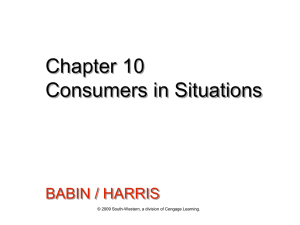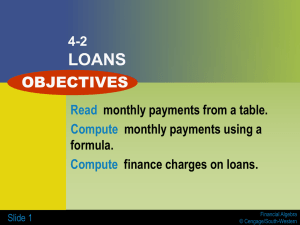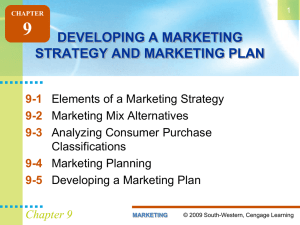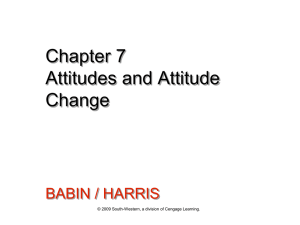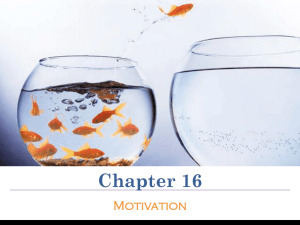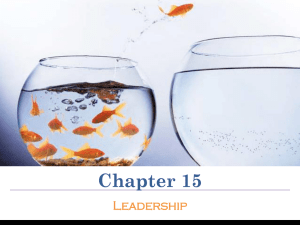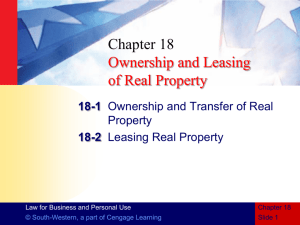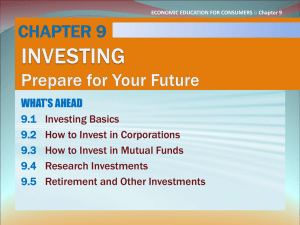Lesson 1-1 - New Bremen Local Schools
advertisement
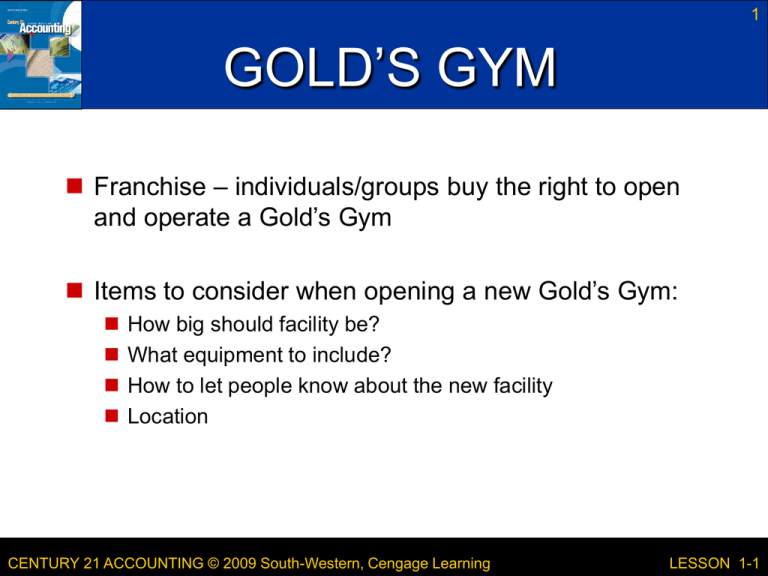
1 GOLD’S GYM Franchise – individuals/groups buy the right to open and operate a Gold’s Gym Items to consider when opening a new Gold’s Gym: How big should facility be? What equipment to include? How to let people know about the new facility Location CENTURY 21 ACCOUNTING © 2009 South-Western, Cengage Learning LESSON 1-1 2 GOLD’S GYM Why is location of a business important to the success of that business? If difficult to get to, customers may not make the effort Not enough parking, customers will not find it convenient If business depends on drop-in customers, it should be located where there is high vehicular or pedestrian traffic If difficult to enter or exit the business, customers may not return If customers must walk from parking lot to get to business, parking lot should be lighted Beneficial to have other popular businesses in the area to attract customers CENTURY 21 ACCOUNTING © 2009 South-Western, Cengage Learning LESSON 1-1 3 GOLD’S GYM What things would you consider when deciding where to locate a business such as Gold’s Gym? Lighted parking lot Accessibility to major roads Ample parking Proximity to public transportation Other popular businesses in the area (Kmart in St. Marys) Easy entrance/exit High vehicular and pedestrian traffic (Coffee Shop) CENTURY 21 ACCOUNTING © 2009 South-Western, Cengage Learning LESSON 1-1 4 Forming & Dissolving a Proprietorship p. 7 In groups of 3, complete the following: 1. Read Business Structures – Forming and Dissolving a Proprietorship 2. Answer the following questions: A. Why do you think more businesses are organized as proprietorships than any other form of business organization? B. What kinds of people do you think would be most successful as owners of a proprietorship? C. List some advantages of a proprietorship D. List some disadvantages of a proprietoship CENTURY 21 ACCOUNTING © 2009 South-Western, Cengage Learning LESSON 1-1 5 Answers A. Why more proprietorships? Proprietorships are the easiest way to organize a business. Owner has the authority to totally control every aspect of the business and does not have to get permission from a partner or from stockholders to make major changes, etc. B. What kinds of people would be successful? Creative, willing to take a risk, self-motivated, good manager of time, enjoys being in charge, not afraid of responsibility, ample knowledge related to the business, good marketing and planning skills CENTURY 21 ACCOUNTING © 2009 South-Western, Cengage Learning LESSON 1-1 6 Answers C. Advantages: Ease of formation/dissolving, Total control by owner, and profits are not shared D. Disadvantages: Limited resources, Unlimited liability, Limited expertise, Limited life, Obligation to follow laws of federal, state, and city in which business is formed CENTURY 21 ACCOUNTING © 2009 South-Western, Cengage Learning LESSON 1-1 7 What is Accounting? Planning, recording, analyzing, and interpreting financial information is called Accounting. A planned process for providing financial information that will be useful to management is called an Accounting System. Organized summaries of a business’s financial activities are called Accounting Records. Accounting is the “Language of Business” CENTURY 21 ACCOUNTING © 2009 South-Western, Cengage Learning LESSON 1-1 8 What is Accounting? Many individuals in a business complete accounting forms and prepare accounting reports Owners, managers, and accounting personnel use their knowledge of accounting to understand the information provided in the accounting reports. Regardless of a person’s responsibility within an organization, it is EXTREMELY beneficial to have a background knowledge of accounting. CENTURY 21 ACCOUNTING © 2009 South-Western, Cengage Learning LESSON 1-1 9 What is Accounting? Financial Statements are financial reports that summarize the financial condition and operations of a business. Can anyone name some financial statements? Uses of Financial Statements: Business owners and managers use these statements to make business decisions Suppliers that are considering extending credit to a business and banks that are considering extending loans to a business will look at a business’s financial statements before granting credit or issuing a loan to the business CENTURY 21 ACCOUNTING © 2009 South-Western, Cengage Learning LESSON 1-1 10 Accounting Tidbits… Inaccurate accounting records often contribute to business failure and bankruptcy Failure to understand accounting information can result in poor business decisions for businesses Nearly everyone earns money, must submit income tax reports to the gov’t Everyone must plan ways to keep spending within available income in both your personal and business lives. CENTURY 21 ACCOUNTING © 2009 South-Western, Cengage Learning LESSON 1-1 11 TechKnow Consulting Service Business – a business that performs an activity for a fee Examples??? Proprietorship – A business owned by one person; also known as sole proprietorship Kim Park is the owner Sets up and troubleshoots computer networks Rents office space and the equipment needed to troubleshoot network problems CENTURY 21 ACCOUNTING © 2009 South-Western, Cengage Learning LESSON 1-1 12 TechKnow Consulting Kim Park must design the accounting system since this is a new business – set up accounts, etc. Kim must keep her business records separate from her personal records Ex. – Kim owns a house and personal car. TechKnow’s accounting records must not include these items Ex. – Kim must have a checking account for her personal expenses and a separate account for TechKnow Consulting Accounting Concept: Business Entity Is applied when a business’s financial information is recorded and reported separately from the owner’s personal information CENTURY 21 ACCOUNTING © 2009 South-Western, Cengage Learning LESSON 1-1 13 FUNDAMENTAL ACCOUNTING TERMS page 8 Assets – anything of value that is owned Assets have value because they can be used either to acquire other assets or to operate a business Ex. - Cash, Supplies Equities – Financial rights to the assets of a business Two Types: 1) Equity of those that the business owes money to (TechKnow may buy supplies from Office Depot and agree to pay for them at a later date. Office Depot has a right to some of TechKnow’s assets until TechKnow pays for the supplies Liabilities – an amount owed by a business 2) Equity of the Owner (Kim Park will own the business and invested some of her own money into the business. She has a right to some of the assets) Owner’s Equity - the amount remaining after the value of all liabilities is subtracted from the value of all assets CENTURY 21 ACCOUNTING © 2009 South-Western, Cengage Learning LESSON 1-1 14 THE ACCOUNTING EQUATION page 8 The relationship among assets, liabilities, and owner’s equity can be written as an equation. An equation showing the relationship among assets, liabilities, and owner’s equity is called the Accounting Equation. THE ACCOUNTING EQUATION MUST ALWAYS BE IN BALANCE The Left side of the equation must always equal the Right side of the equation CENTURY 21 ACCOUNTING © 2009 South-Western, Cengage Learning LESSON 1-1 15 The Accounting Equation - Remember Assets = Liabilities + Owner’s Equity A = L + OE CENTURY 21 ACCOUNTING © 2009 South-Western, Cengage Learning LESSON 1-1




